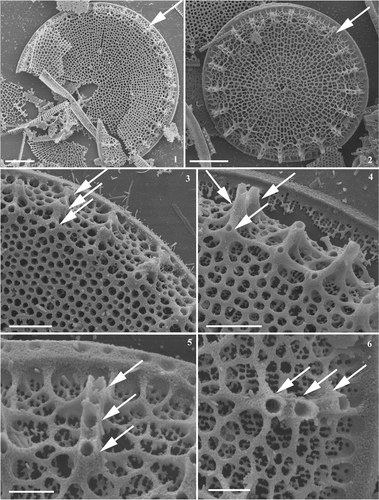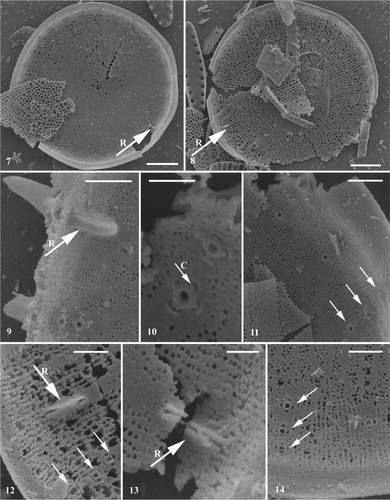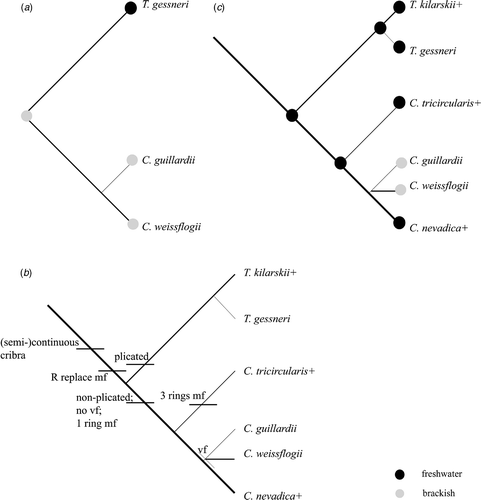Figures & data
Figs 1–6. Conticribra tricircularis sp. nov., SEM, external view of valve. Specimens from the Pliocene sediment from Trout Creek (Oregon, USA). Figs 1, 2. Whole valve surface with non-plicated valve face; valve surface with radiate areolation pattern. Note external openings of marginal fultoportulae forming three regular rings (arrow). Figs 3, 4. Valve surface with loculate areolae arranged in radiate rows, and external openings of marginal fultoportulae usually forming three rings (arrow). Figs 5, 6. Partly dissolved valves, with details of external openings of marginal fultoportulae (arrow) and network of ribs. Scale bars: 5 µm (Figs 1, 2): 2 µm (Figs 3, 4); 1 µm (Figs 5, 6).

Table 1. Fossil record of extinct species in Conticribra and Thalassiosira s.l. with continuous cribra.
Figs 7–14. Conticribra tricircularis sp. nov., SEM, internal view of valve. Specimens from the Pliocene sediment from Trout Creek (Oregon, USA). Figs 7, 8. Internal view of valve surface, showing non-plicated valve face, semi-continuous cribra and three regular rings of marginal fultoportulae. Note absence of valve face fultoportula(e). . Processes (arrow R: rimoportula; arrow: marginal fultoportulae), semi-continuous cribra on valve face and continuous cribra on valve mantle. . Raised rimoportula replacing marginal fultoportulae, externally opened by elongated, spine-like tube, internally oriented along valve radius. . Details of marginal fultoportulae: slightly elongated central tube possessing satellite pore cover (arrow C) and four cowlings. Note hyaline area in process zone. . Partly dissolved valves with processes (arrow R: rimoportula; arrow: marginal fultoportulae), semi-continuous cribra on valve face and continuous cribra on valve mantle. Scale bars: 5 µm (Figs 7, 8); 1 µm (Figs 9, 11, 12, 14); 0.5 µm (Figs 10, 13).

Fig. 15. Diagrams to show phylogenetic relationships and hypothesis of the freshwater origin of Conticribra. (a) Modified from Alverson et al. (Citation2007, ) to include only species relevant to this paper; (b) phylogenetic relationships from a with addition of extinct species of Conticribra and Thalassiosira kilarskii (based on morphology). Abbreviations: mf: marginal fultoportulae; R: rimoportula; vf: valve face fultoportulae; +: extinct species. (c) Phylogenetic relationships from a with addition of extinct species of Conticribra and Thalassiosira kilarskii (based on morphology) showing freshwater origin of the genus and recent brackish water colonizations.
